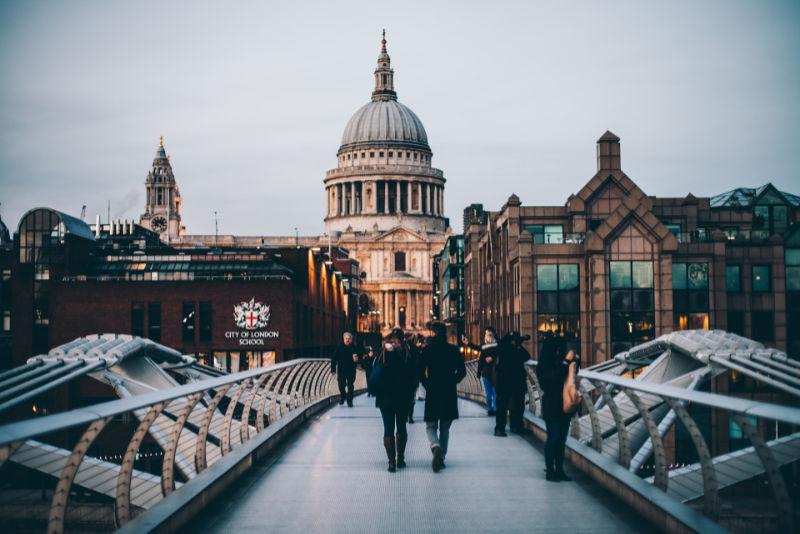Stock images, it’s fair to say, have been subject to no shortage of mockery down the years. We’ve probably all browsed websites with stock images that were just a bit too obviously stock images. Think back to that close-up of the suspiciously glamorous-looking female ‘call-centre worker’ on a site’s contact us page, for example, or the smart-suited businessmen pictured shaking hands, on the backdrop of a city that could be basically any city, anywhere in the world.

Indeed, the anonymous and inauthentic-looking stock photo seems to be a certain aesthetic all of its own, to the point of penetrating popular culture. Did you know, for example, that the now-legendary ‘distracted boyfriend’ meme is based on a stock photo from 2015?
You might imagine, then, that using stock images isn’t a brilliant idea in web design. But has stock photography been unjustly maligned down the years? And even more than that, are there ways in which stock photos can be used to positive effect throughout your website, even in 2019?
First, the case for the prosecution…
As we touched on above, the arguments against stock images are now becoming very familiar, but let’s provide a refresher anyway. Some common ‘offences’ of stock photos are more egregious than others. Consider the especially fake-looking ‘multicultural’ stock image, for instance, of people from a range of ethnic backgrounds stood together smiling for no apparent reason… or those baffling depictions of a professionally-dressed man and woman drawing vague, incomprehensible symbols on a whiteboard or screen.
Web users are generally so accustomed to these stock-photo clichés by now, that they are likely to identify them as such on your site straight away – and in the process, the fact you are using photos that don’t depict your actual team and business. And if you’re already being dishonest with the photos you use on your site, many users will think, what else are you potentially being dishonest about?
Such a lack of authenticity often becomes even more obvious when the stock photos in question are ones the user remembers from other sites they have visited. They know that perpetually grinning ‘quirky’ guy with the hipster moustache and the pretty lady with her brown hair tied back can’t possibly be working for a zillion different companies around the world at once.
Using stock images on your site that are very similar or exactly the same as those used on other sites isn’t just a bit embarrassing. That’s because doing so can also erode the sense of your business’s uniqueness compared to competitors. So, what can you do about it?
The answer isn’t necessarily to ditch stock photos altogether
Now, if this is the part of the article where you expect us to say, avoid stock images like the plague… you’d be wrong. You see, an all-too-little known ‘secret’ of web design is that stock photos actually can be good and useful when they are used in the right ways, at the right times.
Let’s consider, for instance, the aforementioned clichéd nature of stock images. What if you specifically need certain images on your site to be clichéd, so that visitors immediately recognise what they’re supposed to signify? Icons and vector graphics are a great example of this. Just consider the ‘gear’ icon, which almost all of us instantly associate with ‘settings’ of some kind, or the ‘magnifying glass’ one, which is widely used next to the ‘search’ function of a given site.
Stock photos can also be genuinely useful for backgrounds or ‘hero’ images – the latter referring to the large image with text that is often the first thing you see when you visit a particular site. It’s in these parts of a site where slightly more generic imagery can often work really well. After all, such photos’ chief purpose is to grab the eye of the visitor, have a certain emotional effect on them and intrigue them enough to encourage them to further browse the site.
Do bear in mind, though, that if you are using stock images in these areas of your site, they will – of course – need to be of high visual quality, being of sufficient resolution to work well with any screen and device. Thankfully, the extremely broad range of available stock images will help you to find photos that are a good match for your brand and the messages you wish to communicate.
Other contexts in which it can make a lot of sense to use stock images include for depicting specific geographical locations, as well as if you need some informative photos to complement educational content or to fit in with a certain wider website colour scheme.
If you are a hotel based in London or Manchester, for example, or even a smaller town, there is likely to be no shortage of attractive stock images available of these locations that might look better than what you could take yourself, while also – of course – saving you the time and effort of doing so.

The verdict: always use stock images responsibly
As we’ve touched on above, there are plenty of reasons not to consider using stock images to be some kind of heinous crime in web design.
While, here at Success Local, we don’t believe that stock photography should be your primary go-to strategy when you are seeking images for your website, they can still provide a high-quality finish if there are no unique, high-quality company photos available.
Ultimately, then, the question isn’t whether using stock images makes sense – it’s whether it makes sense for the given parts of your website where you propose to use them, in the wider context of what you wish to convey with your site.
For further guidance and assistance when you are looking to design and build the most impactful website for the business world of 2021 and beyond, don’t hesitate to give the Success Local web design team in Leicester a call on 01788 288 800.
Posted in Web Wednesdays
